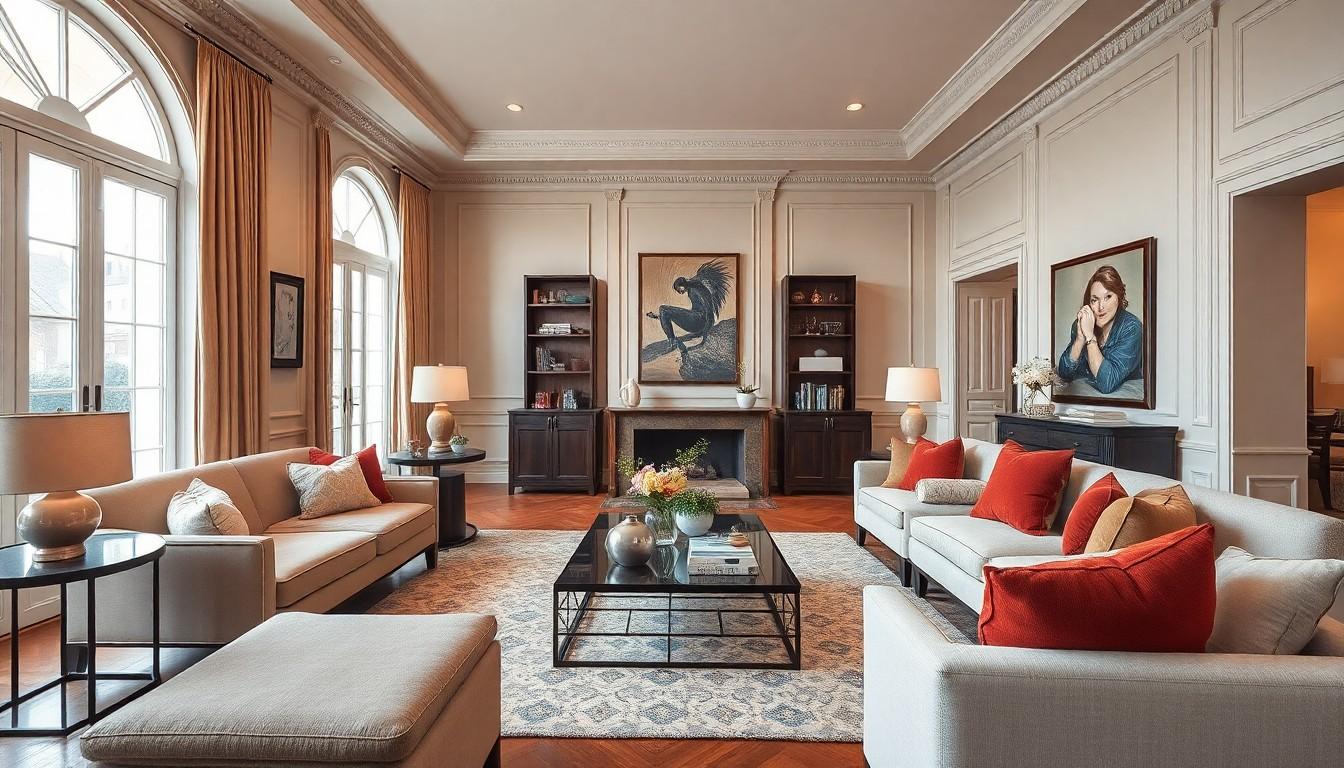Key Takeaways
- Blending Styles: Transitional home design combines traditional and contemporary elements, creating a timeless yet modern aesthetic that appeals to diverse tastes.
- Color and Texture: Neutral color palettes dominate, punctuated by bold accents, while a mix of textures—from wood to metal—enhances visual interest and warmth.
- Furniture Selection: Key furniture pieces feature clean lines and functional forms, merging classic shapes with modern materials for both comfort and style.
- Lighting and Accessories: Thoughtful lighting choices and carefully selected accessories reinforce the design’s cohesiveness, contributing to the overall ambiance of the space.
- Functional Layout: Effective room layouts promote flow and usability, with clear zones for different activities enhancing livability while maintaining an inviting atmosphere.
- Storage Solutions: Innovative storage, such as built-ins and multi-functional furniture, maximizes functionality without sacrificing aesthetic appeal in transitional designs.
Transitional home design effortlessly blends traditional and contemporary elements, creating spaces that feel both timeless and fresh. This style appeals to those who appreciate the elegance of classic design but also crave the clean lines and open spaces of modern aesthetics. By harmonizing the best of both worlds, transitional design offers a versatile solution for homeowners seeking a balanced and inviting atmosphere.
Incorporating a mix of textures, colors, and furnishings, transitional design invites creativity while maintaining a cohesive look. Whether it’s through the use of neutral palettes or the careful selection of statement pieces, this approach allows for personal expression without overwhelming the senses. As more people embrace this adaptable style, understanding the principles behind transitional home design becomes essential for anyone looking to create a welcoming and stylish living environment.
Transitional Home Design
Transitional home design merges the classic beauty of traditional elements with the sleek simplicity of contemporary styles. This hybrid approach caters to individuals who appreciate timeless elegance combined with modern trends.
Key characteristics of transitional design include:
- Color Palette: Neutral tones dominate, with occasional bursts of bold hues. This balance creates a soothing environment while allowing for creativity.
- Textures: A variety of textures enhances visual interest. Common materials include wood, metal, and glass, bringing warmth and sophistication to spaces.
- Furniture Selection: Furniture pieces showcase clean lines and functional form. Styles blend classic shapes with modern materials, ensuring comfort and style coexist.
- Lighting: Knotted with both modern and traditional fixtures, lighting significantly contributes to the overall ambiance. Statement pieces often serve as focal points in transitional rooms.
- Accessories: Thoughtfully chosen accessories tie the design together. Artwork, rugs, and decorative items reflect a blend of styles, reinforcing the cohesive feel.
Transitional home design emphasizes comfort and livability, making spaces inviting and practical. This style appeals to those seeking a refined yet approachable atmosphere in their living environments.
Key Features of Transitional Home Design

Transitional home design incorporates both traditional and contemporary features, creating an enduring aesthetic that remains inviting and functional. Key aspects include a harmonious blend of styles, a thoughtful color scheme, and carefully selected materials.
Blending Traditional and Contemporary Elements
Transitional design artfully merges traditional features like classic moldings and ornate details with contemporary elements such as streamlined furnishings and minimalism. Designers often utilize traditional fabrics in modern patterns, creating a unique dialogue between past and present. This blend provides flexibility for personal expression while maintaining cohesive aesthetics. Furniture pieces often mix vintage designs with sleek silhouettes, striking a balance that caters to both comfort and elegance.
Color Palette and Material Choices
Neutral color palettes dominate transitional design, with whites, grays, and beiges serving as foundational hues. Occasionally, bold colors accentuate specific areas or accessories, providing an eye-catching contrast. Material choices reflect diversity and texture, incorporating wood, metal, glass, and fabric. Wood elements often feature warm finishes to add organic warmth, while metal accents bring a touch of modernity. The careful selection of textiles, such as linen or cotton, enhances comfort and adds visual interest, ensuring spaces feel layered and inviting.
Furniture and Decor in Transitional Homes
Transitional homes utilize a blend of furniture and decor that harmonizes traditional and modern elements. This mix fosters an inviting environment that reflects personal style while maintaining cohesiveness.
Selecting the Right Furniture Pieces
Selecting furniture pieces in transitional design emphasizes the importance of balance. Opt for furniture with clean lines and subtle curves. Choose sofas and chairs upholstered in neutral tones, integrating pops of color through accent pillows or throws. Incorporate wooden furniture with warm finishes to add warmth and texture. Include functional pieces, such as multi-purpose ottomans or coffee tables with storage, which enhance usability without sacrificing style. Consider items made from a mix of materials, like metal accents or glass tabletops, furthering the contemporary touch while retaining a classic essence.
Incorporating Art and Accessories
Incorporating art and accessories into transitional homes reinforces the design’s cohesive feel. Select artwork that features abstract or simplistic designs to align with the overall aesthetic. Hang framed prints or large canvases in neutral or bold colors that complement the chosen palette. Layering accessories like vases, books, and sculptures helps create visual interest and depth. Choose decorative items that blend different materials, such as ceramic and metal, adding to the eclectic mix. Use mirrors strategically to amplify light and space, creating an airy atmosphere while maintaining the transitional theme.
Creating a Functional Space
Creating a functional space in transitional home design balances aesthetics and practicality. Thoughtful planning enhances the livability and flow of each room, ensuring comfort and style coexist seamlessly.
Room Layout and Design Flow
Room layout and design flow significantly impact the functionality of transitional spaces. Open floor plans promote an airy feel and facilitate movement between areas. Arranging furniture to encourage conversation enhances social interactions. Grouping seating arrangements, like sofas and chairs, around a central coffee table fosters engagement while maintaining accessibility.
Clearly defined zones for different activities ensure efficiency. For example, designating a reading nook with a cozy chair and ample lighting promotes relaxation without disrupting the overall flow. Additionally, maintaining clear pathways prevents clutter and promotes user-friendly access to essential spaces.
Storage Solutions in Transitional Designs
Effective storage solutions enhance both function and design in transitional homes. Incorporating built-in shelves and cabinetry preserves space while providing organization. Selecting multi-functional furniture, like storage ottomans and bench seating, maximizes usability without compromising style.
Hidden storage options also play a crucial role. Utilizing under-bed storage or utilizing decorative boxes can conceal items while contributing to the overall design aesthetic. Prioritizing clean lines and subtle hardware in storage solutions aligns with transitional themes, ensuring they complement rather than detract from the visual harmony of the space.
Blend Of Tradition And Modernity
Transitional home design stands out as a perfect blend of tradition and modernity. It creates spaces that are not only visually appealing but also highly functional. By carefully selecting elements that harmonize classic and contemporary styles, homeowners can achieve a unique aesthetic that reflects their personal taste.
This design approach encourages creativity while maintaining a sense of balance and cohesion. With its focus on comfort and livability, transitional design remains a popular choice for those looking to create inviting environments. Ultimately, it offers a timeless solution that adapts to changing trends while ensuring spaces feel fresh and welcoming.
